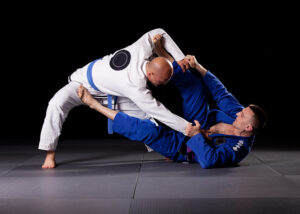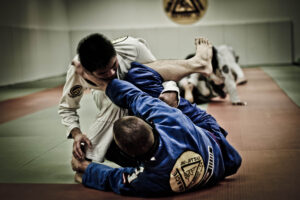Brazilian Jiu-Jitsu
South Florida Jiu Jitsu and MMA chiropractic
Jiu-Jitsu is a particularly unique martial art and sport in which the majority of a match is played with one or both competitors on the ground either on their back, on their behind, half kneeling or full kneeling positions.
What makes a jiu-jitsu athlete unique is that throughout their training they will learn to be comfortable in several positions and be able to both simultaneously attack their opponent and defend themselves from each of these positions.
To build a perfect body for longevity in jiu-jitsu, we must break down each position and the mobility and stability requirements from each position to be healthy and effective in the sport.
The Importance of Mobility in Jiu-Jitsu
Mobility can be defined as the ability for one joint to express a full range of motion independent of other motion in the body. An example of this in jiu-jitsu that most can relate to is the hips. At some point in your jiu-jitsu training, you have likely encountered an individual who has a near-impossible guard to pass due to his hips being extremely flexible as well as good speed to pummel their legs and recover guard. This is a prime example of using mobility to your advantage to improve your jiu-jitsu. In other cases, you have likely encountered an individual who is very prone to be “stacked” in the guard due to hip immobility. Even if an individual is taught the proper technique to retain and attack from the guard position, if their hips cannot keep up with the position or passing of their opponent, they leave themselves vulnerable to both being passed and being injured.
The Importance of Stability in Jiu-Jitsu
Stability can be defined as our body’s’ ability to keep certain areas of your body still and balanced while moving or being moved in other areas of your body. A great example of this is passing the guard. As a jiu-jitsu player, you have likely encountered the individual who has such a great base that they seem impossible to sweep or control from the bottom position. Even when controlling one of these individuals’ legs or having a deep grip on their collar, there is something about this individual that makes them an immovable object. Having excellent stability, particularly in your “core”, will allow you to move quickly, powerfully and efficiently on the mat, all while significantly reducing your chance of injury.
At Miami Spine and Performance we work with many jiu-jitsu athletes, both recreational enthusiasts, and high-level competitors throughout Hallandale, Aventura, and Hollywood. We have found that many of our jiu-jitsu athletes present to the clinic with neck and lower back pain that is ultimately a result of poor respiration, core stability, and hip control during training. In our Jiu-Jitsu Injury Prevention video series, we are going to share 3 of the primary exercises we use with our jiu-jitsu athletes to keep them healthy on the mats and performing at a high level in competitions. We will cover the basics of proper respiration, as well as how to properly train your hip for both stability and mobility.
Jiu-Jitsu Injury Prevention: Breathing
Proper Respiration is the foundation of any good athletic movement but is particularly important for Jiu-Jitsu because of the dynamic nature of the sport and the regular transition between positions. To smoothly transition between positions, maintain cardiovascular performance and maintain a strong base is contingent upon your ability to use your respiratory and stability diaphragm muscle in sync.
Not only does proper diaphragm function and intra-abdominal pressure improve your performance, but it also protects your spine from injury during training. The actual strength of the core muscles does not prevent injury, but rather your ability to generate pressure in your abdomen to create stability around your spine and prevent bucking of the vertebrae.
Our goal with training the diaphragm is to produce pressure in the abdomen in 360 degrees with each inhale and to be able to maintain 20-30% of that pressure during exhalation. Once you can accomplish this task lying on your back with your legs elevated, challenge your breathing in different positions! (Example: Face down, side-lying, half kneeling, in guard)
Watch the video below for instructions on how to begin training your breathing and core stability for Jiu-Jitsu!
Jiu-Jitsu Injury Prevention: Hip Stability
Once you have established your intra-abdominal pressure, you have already successfully built the foundation for good stability in jiu-jitsu.
In addition to intra-abdominal pressure, it is also crucial that you have good centration and stability in your hips. This will allow you to sit back into your hips and use them explosively when shooting for a takedown. Hip stability means more than just strength, there are plenty of individuals with an impressive leg press but no hip stability.
Hip stability is a product of proper hip centration and the ability to produce force from all different angles. Not only will it strengthen your standing position, but also is beneficial in both the top and bottom position on the ground. When passing guard at higher levels, most individuals are standing and must have an excellent base to not be off-balanced by their opponent.
It is important to note that strength does not equal balance. Balance starts with centration. Many individuals are shocked when they can put up large numbers in the weight room on exercises like squat, lunge and leg press but are unable to properly bridge with their hip. A lot of the stability demands required for Jiu-Jitsu fall on the small musculature of the hip.
Watch the video link below for how to train hip centration and stability properly for Jiu-Jitsu!
Jiu-Jitsu Injury Prevention: Hip Mobility
Before we dive into the importance of hip mobility for jiu-jitsu and how to train it, let’s first discuss the difference between mobility and flexibility. Flexibility is the ability to passively stretch muscular, tendon, and ligament tissue beyond its resting length. Mobility, on the other hand, is the ability to control soft tissues in their end range of motion. This means that flexibility is a prerequisite for mobility.
For example, If an opponent can push your feet behind your head and you feel a very little stretch in your back or hips, this would be an example of excellent flexibility, but this doesn’t necessarily mean that this position is safe or ideal for your body. However, if you can bring your feet behind your head on your own without compromising other areas of your body, this would demonstrate excellent mobility and means that you can safely control this position and use it as part of your game.
In addition to improving your jiu-jitsu game and giving you more options on the mat, having great hip mobility also reduces the strain on your lower back when training. The large majority of lower back injuries are the result of overloading on the joints of the lower back due to inadequate movement of the thoracic spine (middle back) and the hips. Therefore, improving the movement quality of your hips can greatly reduce your incidence of lower back pain and prevent injury in the long term.
Most individuals mistake flexibility training for mobility training. Holding stretches or rocking back-and-forth are not adequate means of improving mobility, particularly if your goal is to build strong and efficient hips to use in a contact sport such as jiu-jitsu. To improve hip mobility and create lasting changes that impact the long-term, it must be trained just like any other physical capacity.
Learn how to train your hip mobility by clicking the link below!
If you are a Brazilian jiu-jitsu athlete currently dealing with an injury or just want to learn more about your body and how to stay injury-free, schedule a consultation with one of our sports chiropractors below!



